Gaming for Training Voluntary Control of Pupil Size
Abstract
1. Introduction
Pupil in Software Control
2. Materials and Methods
2.1. Hardware
- SBC Raspberry Pi 4 model B, 4 GB RAM (Raspberry Pi Foundation, Cambridge, UK). The previous platform was based on a Raspberry Pi 3 [24], we chose the fourth generation for the improved computational power, the double microHDMI video output, useful to connect both the touch screen and the external monitor needed for the game, and the low cost (75 USD);
- 32 GB microSD. Needed for the SBC to load the operative system;
- 2.0 MP 1080p USB IR camera (Shenzen DingDang Smart Technology Co., Ltd., Shenzen, China). This camera is the same used for the previous platform [24];
- IR led. Used to enhance pupil contrast;
- 5 inch hdmi display xpt2046 touch controller (Elecrow). The resolution and the precision of this screen make it suitable for menu navigation using virtual buttons (Figure 1b);
- 2 speakers (Reyes 8002). Connected exploiting pulse width modulation (PWM) pins on the Raspberry Pi 4, the speakers dimension allow them to fit inside the 3D-printed case;
- 3D printed structure mounted on a cut eyeglasses frame;
- 3D printed case. Since the device is developed be portable, a compact 3D-printed case was used Figure 1;
- MicroHDMI-to-HDMI cable. Used to connect the device and an external monitor
2.2. Software
2.2.1. Pupil Size Monitoring
- 1.
- Grayscaling;
- 2.
- Binarization;
- 3.
- Morphological dilatation;
- 4.
- Filling of closed contours;
- 5.
- Connected components analysis where pupil selection is based on:
- Connected component mean value,
- Connected component dimension,
- Connected component eccentricity.
- 1.
- Grayscaling;
- 2.
- Thresholding;
- 3.
- Morphological closing;
- 4.
- Edges detection using Canny method;
- 5.
- Connected component analysis to detect the largest connected component, that we presume is the pupil contour;
- 6.
- Find the ellipse that best fits this contour;
- 7.
- Compute ellipse area.
2.2.2. How the Game Works
2.2.3. Flowchart
2.2.4. Converting Pupil Size to Spaceship Vertical Position
2.3. Tests on Healthy and Patients
- 1.
- How much did you feel in control of the spaceship on a scale from 1 to 5?
- 2.
- How much fun did you have on a scale from 1 to 5?
- 3.
- How much effort did the game require on a scale from 1 to 5?
- 4.
- Did you perceive yourself improving during the rounds?
- Patient A: 56 years old, male, was having problems using current eye-tracking device since many months at the time of the test;
- Patient B: 34 years old, female, has been using an eye-tracker communicator for three years and still uses it with ease at the time of the test;
- Patient C: 52 years old, male, was having problems using current eye-tracking device since many months at the time of the test;
3. Results
3.1. Healthy Subjects
- Control: none of the subjects felt perfectly in control of the ship (score: 5/5) but also none felt completely out of control (score: 1/5).
- Effort: this is the parameter with the highest variability. Some of the subjects easily managed to raise the ship at their will while for others several attempts were necessary to correctly and timely activate the PAR.
- Fun: no subject gave the lowest score to this parameter, but while some subjects found the game interesting others found it a bit boring due to the monotony and low repeatability of the task, even if the bubbles spawn at random places and time intervals.
- Perceived improvement: improvement was not numerically quantified, but all subjects reported that the control of the spaceship progressively improved during the repetitions of the game.
3.2. Patients
- Control: 3 out of 5.
- Effort: 2 out of 5.
- Fun: 5 out of 5.
- Perceived improvement: Yes.
4. Discussion
5. Conclusions
Author Contributions
Funding
Institutional Review Board Statement
Informed Consent Statement
Data Availability Statement
Conflicts of Interest
Abbreviations
| AAC | augmentative and alternative communication |
| ALS | amyotrophic lateral sclerosis |
| BOLD | blood oxygenation level-dependent |
| BCIs | brain-computer interfaces |
| CLIS | complete locked-in state |
| EEG | electroencephalogram |
| fMRI | functional magnetic resonance imaging |
| HR | heart rate |
| IQR | interquartile range |
| IR | infra-red |
| LIS | locked-in state |
| NIRS | near-infrared spectroscopy |
| PAR | pupillary accommodative response |
| PWM | pulse width modulation |
| ROI | region of interest |
| SC | skin conductivity |
References
- Caligari, M.; Godi, M.; Guglielmetti, S.; Franchignoni, F.; Nardone, A. Eye tracking communication devices in amyotrophic lateral sclerosis: Impact on disability and quality of life. Amyotroph. Lateral Scler. Front. Degener. 2013, 14, 546–552. [Google Scholar] [CrossRef] [PubMed]
- Hwang, C.S.; Weng, H.H.; Wang, L.F.; Tsai, C.H.; Chang, H.T. An eye-tracking assistive device improves the quality of life for ALS patients and reduces the caregivers’ burden. J. Mot. Behav. 2014, 46, 233–238. [Google Scholar] [CrossRef] [PubMed]
- Linse, K.; Rüger, W.; Joos, M.; Schmitz-Peiffer, H.; Storch, A.; Hermann, A. Usability of eyetracking computer systems and impact on psychological wellbeing in patients with advanced amyotrophic lateral sclerosis. Amyotroph. Lateral Scler. Front. Degener. 2018, 19, 212–219. [Google Scholar] [CrossRef] [PubMed]
- Van Es, M.A.; Hardiman, O.; Chio, A.; Al-Chalabi, A.; Pasterkamp, R.J.; Veldink, J.H.; Van den Berg, L.H. Amyotrophic lateral sclerosis. Lancet 2017, 390, 2084–2098. [Google Scholar] [CrossRef]
- Hardiman, O.; Al-Chalabi, A.; Chio, A.; Corr, E.M.; Logroscino, G.; Robberecht, W.; Shaw, P.J.; Simmons, Z.; Van Den Berg, L.H. Amyotrophic lateral sclerosis. Nat. Rev. Dis. Prim. 2017, 3, 1–19. [Google Scholar] [CrossRef]
- Beukelman, D.R.; Fager, S.; Ball, L.; Dietz, A. AAC for adults with acquired neurological conditions: A review. Augment. Altern. Commun. 2007, 23, 230–242. [Google Scholar] [CrossRef]
- Bauer, G.; Gerstenbrand, F.; Rumpl, E. Varieties of the locked-in syndrome. J. Neurol. 1979, 221, 77–91. [Google Scholar] [CrossRef]
- Chaudhary, U.; Birbaumer, N.; Ramos-Murguialday, A. Brain–computer interfaces for communication and rehabilitation. Nat. Rev. Neurol. 2016, 12, 513–525. [Google Scholar] [CrossRef]
- Chaudhary, U.; Birbaumer, N.; Ramos-Murguialday, A. Brain–computer interfaces in the completely locked-in state and chronic stroke. Prog. Brain Res. 2016, 228, 131–161. [Google Scholar]
- Ekman, I.; Poikola, A.; Mäkäräinen, M.; Takala, T.; Hämäläinen, P. Voluntary pupil size change as control in eyes only interaction. In Proceedings of the 2008 Symposium on Eye Tracking Research & Applications, Savannah, GA, USA, 26–28 March 2008; pp. 115–118. [Google Scholar]
- Rojas, P.; Ramírez, A.I.; Fernández-Albarral, J.A.; López-Cuenca, I.; Salobrar-García, E.; Cadena, M.; Elvira-Hurtado, L.; Salazar, J.J.; de Hoz, R.; Ramírez, J.M. Amyotrophic lateral sclerosis: A neurodegenerative motor neuron disease with ocular involvement. Front. Neurosci. 2020, 14, 566858. [Google Scholar] [CrossRef]
- Cozza, F.; Lizio, A.; Greco, L.C.; Bona, S.; Donvito, G.; Carraro, E.; Tavazzi, S.; Ticozzi, N.; Poletti, B.; Sansone, V.A.; et al. Ocular involvement occurs frequently at all stages of amyotrophic lateral sclerosis: Preliminary experience in a large Italian cohort. J. Clin. Neurol. 2021, 17, 96. [Google Scholar] [CrossRef]
- Baltadzhieva, R.; Gurevich, T.; Korczyn, A.D. Autonomic impairment in amyotrophic lateral sclerosis. Curr. Opin. Neurol. 2005, 18, 487–493. [Google Scholar] [CrossRef]
- Ponzio, F.; Villalobos, A.E.L.; Mesin, L.; de’Sperati, C.; Roatta, S. A human-computer interface based on the “voluntary” pupil accommodative response. Int. J. Hum.-Comput. Stud. 2019, 126, 53–63. [Google Scholar] [CrossRef]
- Chirre, E.; Prieto, P.; Artal, P. Dynamics of the near response under natural viewing conditions with an open-view sensor. Biomed. Opt. Express 2015, 6, 4200–4211. [Google Scholar] [CrossRef]
- Kasthurirangan, S.; Glasser, A. Characteristics of pupil responses during far-to-near and near-to-far accommodation. Ophthalmic Physiol. Opt. 2005, 25, 328–339. [Google Scholar] [CrossRef]
- McDougal, D.H.; Gamlin, P.D. Autonomic control of the eye. Compr. Physiol. 2015, 5, 439. [Google Scholar]
- Villalobos, A.E.L.; Giusiano, S.; Musso, L.; de’Sperati, C.; Riberi, A.; Spalek, P.; Calvo, A.; Moglia, C.; Roatta, S. When assistive eye tracking fails: Communicating with a brainstem-stroke patient through the pupillary accommodative response—A case study. Biomed. Signal Process. Control 2021, 67, 102515. [Google Scholar] [CrossRef]
- Kotchoubey, B.; Lang, S.; Winter, S.; Birbaumer, N. Cognitive processing in completely paralyzed patients with amyotrophic lateral sclerosis. Eur. J. Neurol. 2003, 10, 551–558. [Google Scholar] [CrossRef]
- Lohse, K.; Shirzad, N.; Verster, A.; Hodges, N.; Van der Loos, H.M. Video games and rehabilitation: Using design principles to enhance engagement in physical therapy. J. Neurol. Phys. Ther. 2013, 37, 166–175. [Google Scholar] [CrossRef]
- Lin, C.S.; Huan, C.C.; Chan, C.N.; Yeh, M.S.; Chiu, C.C. Design of a computer game using an eye-tracking device for eye’s activity rehabilitation. Opt. Lasers Eng. 2004, 42, 91–108. [Google Scholar] [CrossRef]
- Ekman, I.M.; Poikola, A.W.; Mäkäräinen, M.K. Invisible eni: Using gaze and pupil size to control a game. In Proceedings of the CHI’08: CHI Conference on Human Factors in Computing Systems, Florence, Italy, 5–10 April 2008; pp. 3135–3140. [Google Scholar]
- Partala, T.; Jokiniemi, M.; Surakka, V. Pupillary responses to emotionally provocative stimuli. In Proceedings of the 2000 Symposium on Eye Tracking Research & Applications, Palm Beach Gardens, FL, USA, 6–8 November 2000; pp. 123–129. [Google Scholar]
- Chiarion, P.; Terna, M.; Di Cataldo, R.P. e-Pupil: IoT-based Augmentative and Alternative Communication device exploiting the pupillary near-reflex. 2022; manuscript submitted. [Google Scholar]
- Vázquez Romaguera, T.; Vázquez Romaguera, L.; Castro Piñol, D.; Vázquez Seisdedos, C.R. Pupil Center Detection Approaches: A Comparative Analysis. Comput. Y Sist. 2021, 25, 67–81. [Google Scholar] [CrossRef]
- Mathôt, S.; Melmi, J.B.; Van Der Linden, L.; Van der Stigchel, S. The mind-writing pupil: A human-computer interface based on decoding of covert attention through pupillometry. PLoS ONE 2016, 11, e0148805. [Google Scholar] [CrossRef] [PubMed]
- Stoll, J.; Chatelle, C.; Carter, O.; Koch, C.; Laureys, S.; Einhäuser, W. Pupil responses allow communication in locked-in syndrome patients. Curr. Biol. 2013, 23, R647–R648. [Google Scholar] [CrossRef] [PubMed]
- De’Sperati, C.; Roatta, S.; Zovetti, N.; Baroni, T. Decoding overt shifts of attention in depth through pupillary and cortical frequency tagging. J. Neural Eng. 2021, 18, 036008. [Google Scholar] [CrossRef] [PubMed]
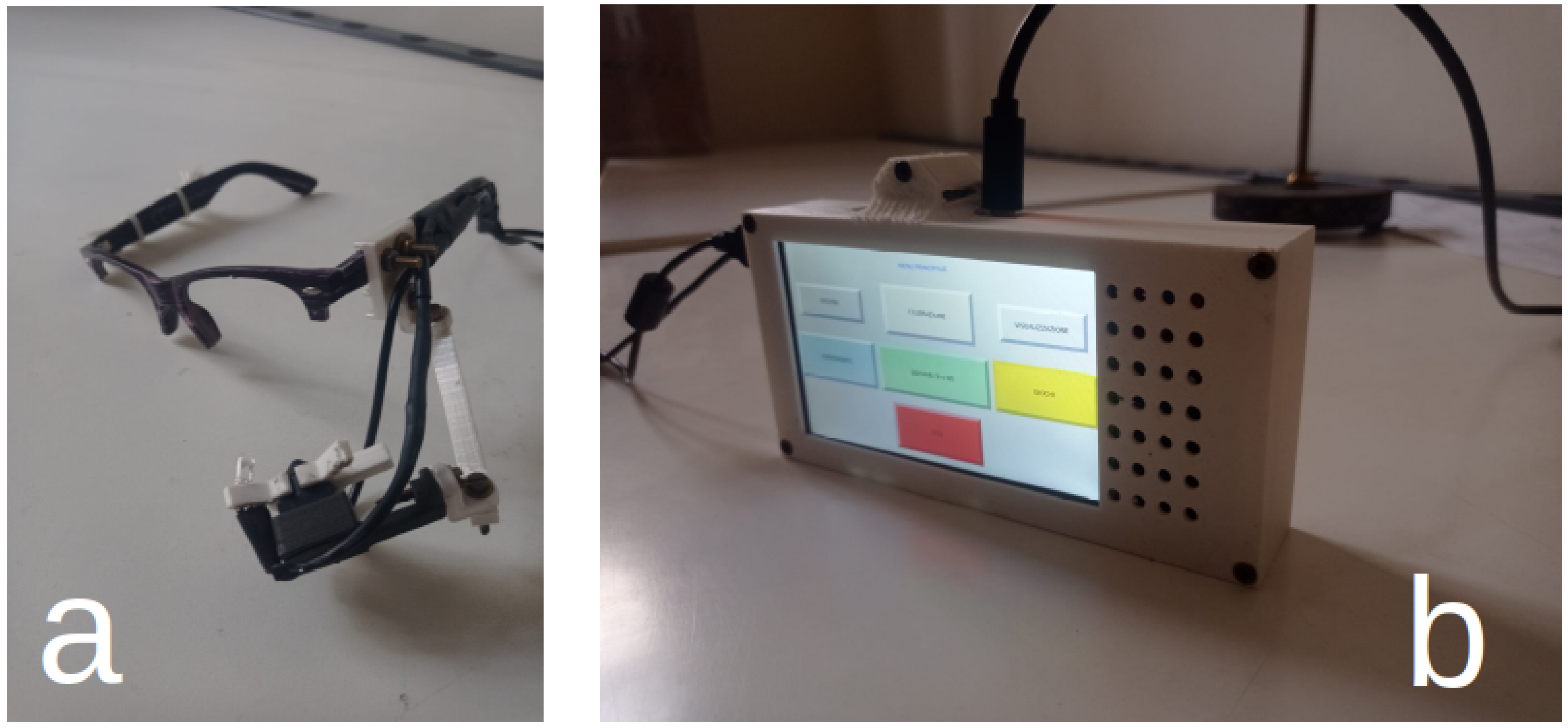
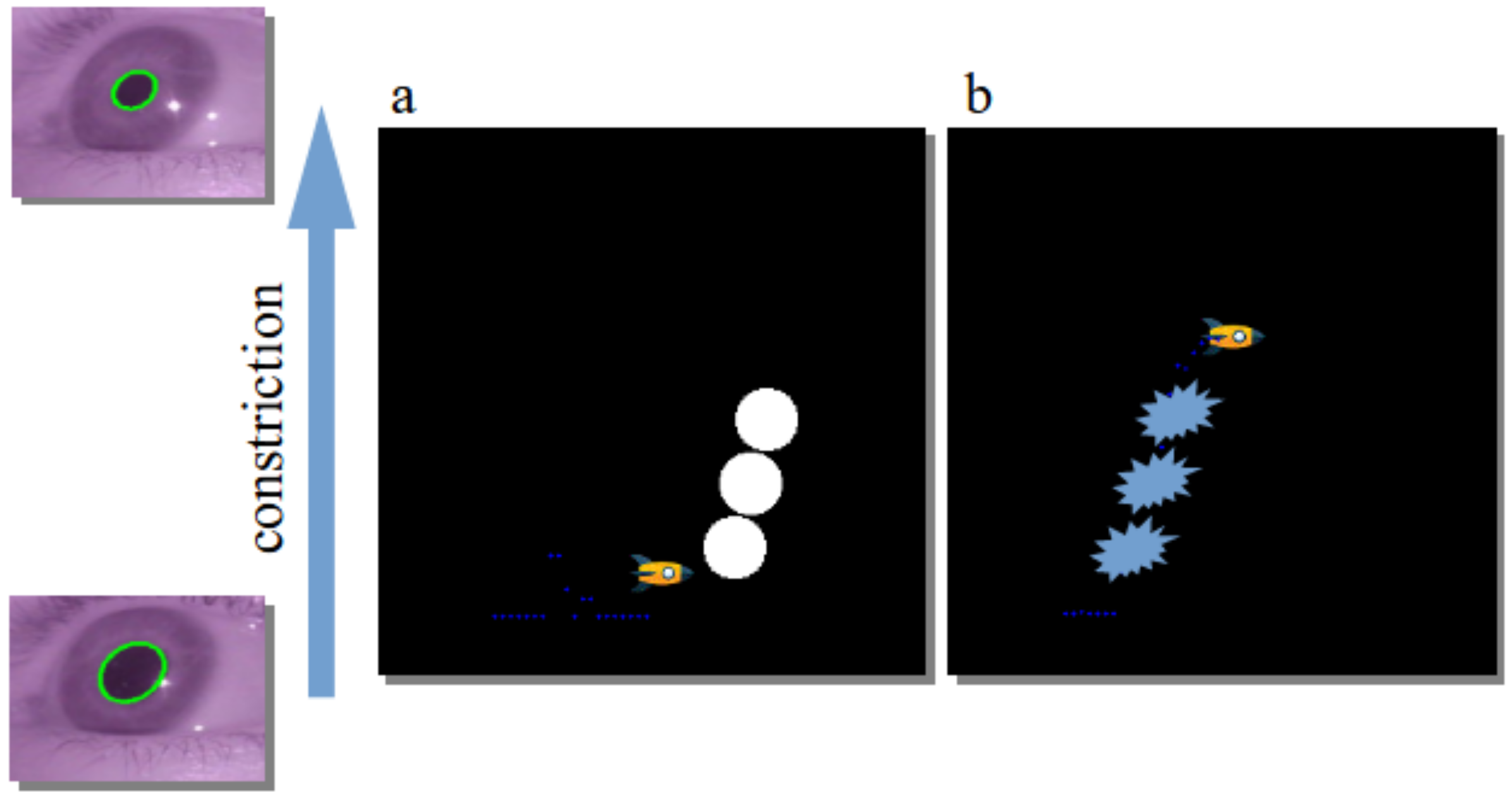
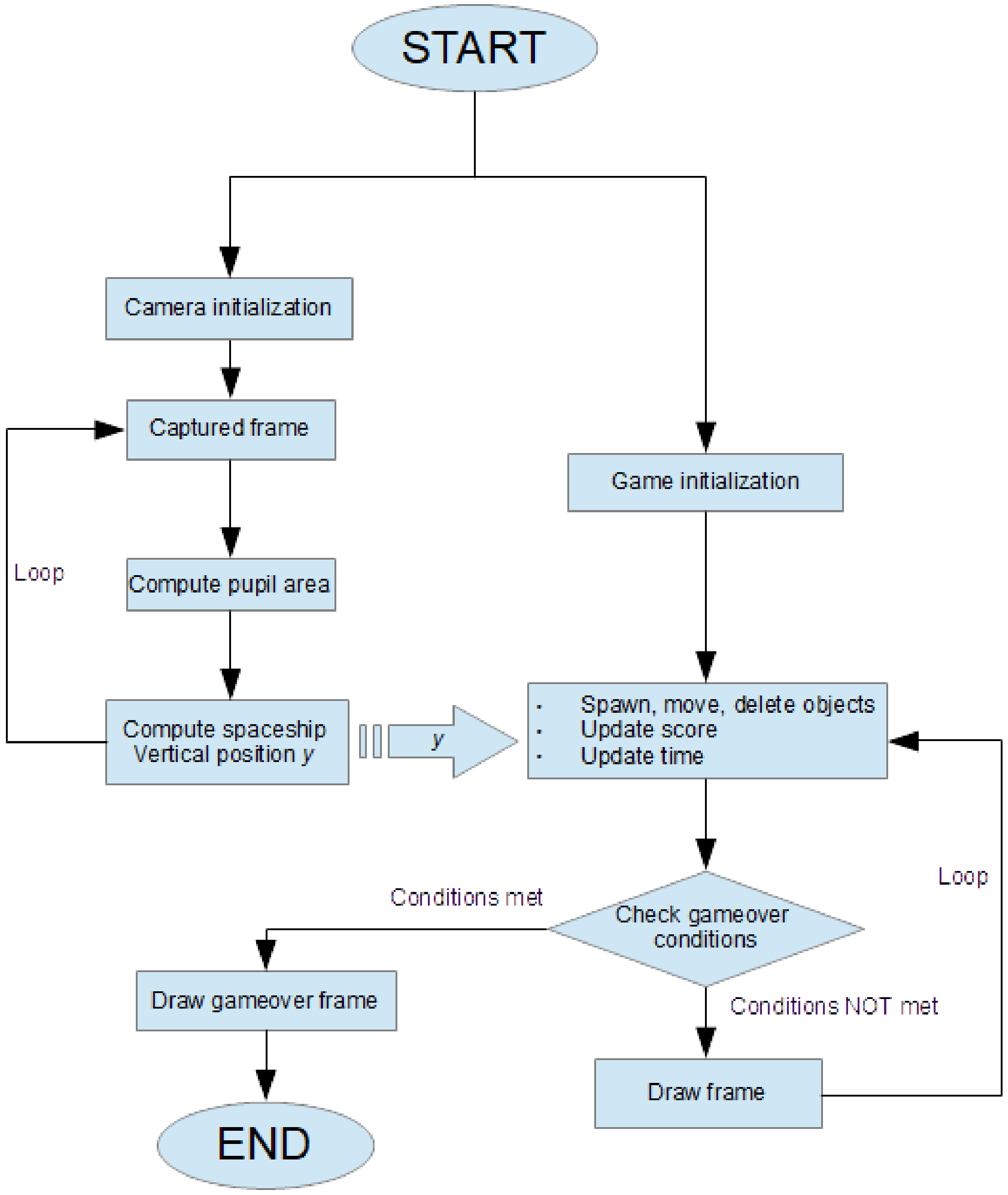
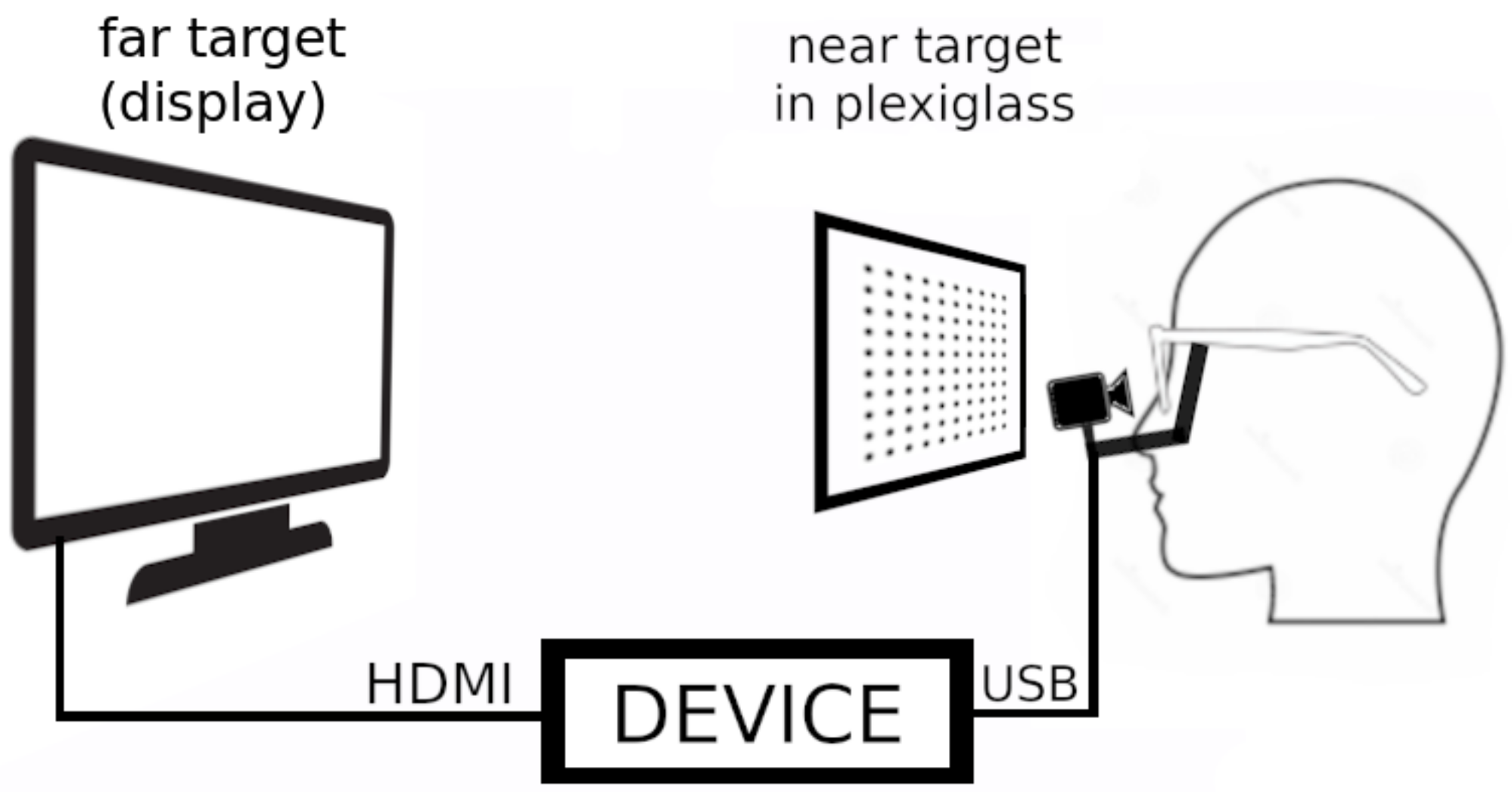
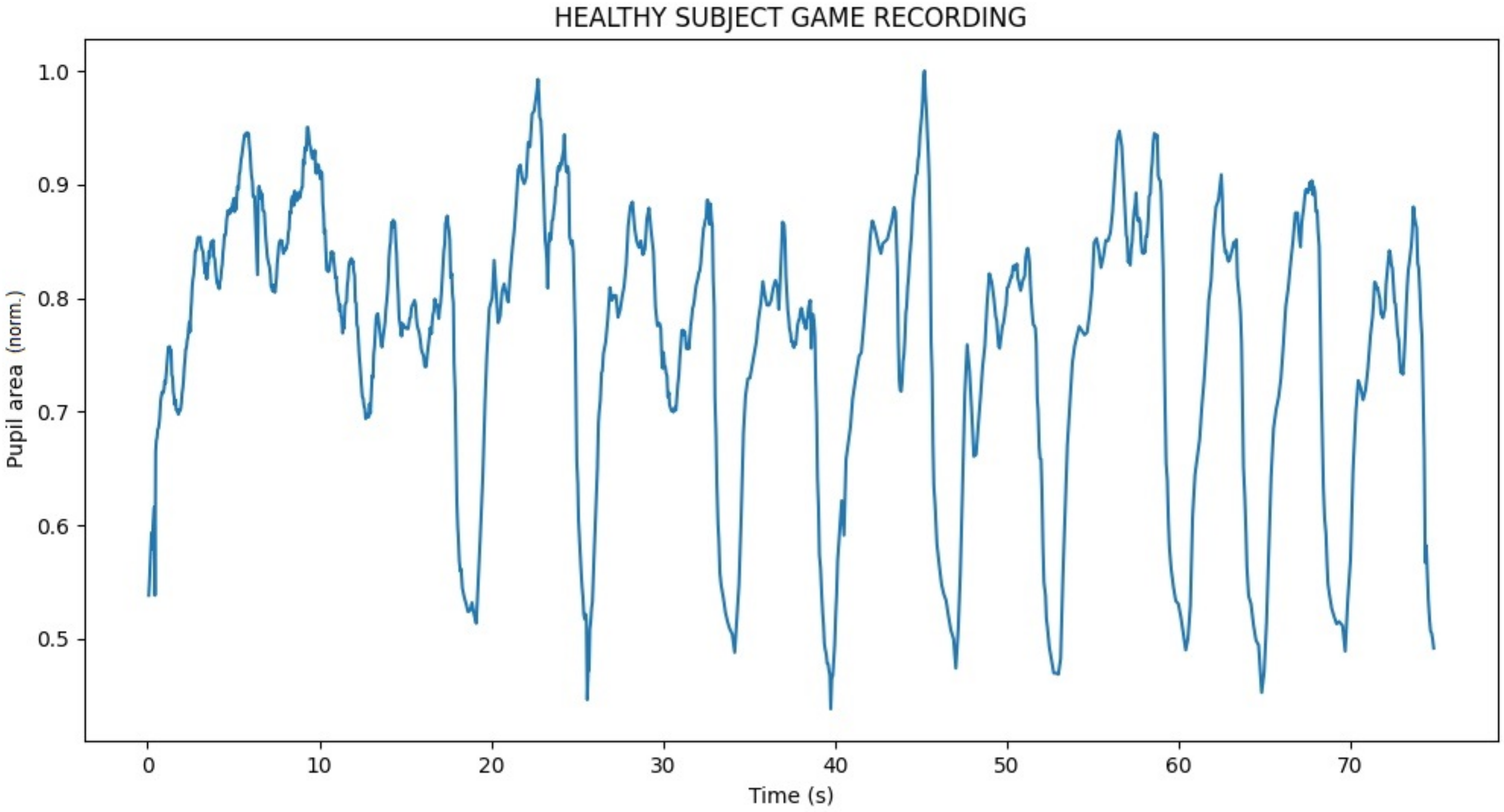


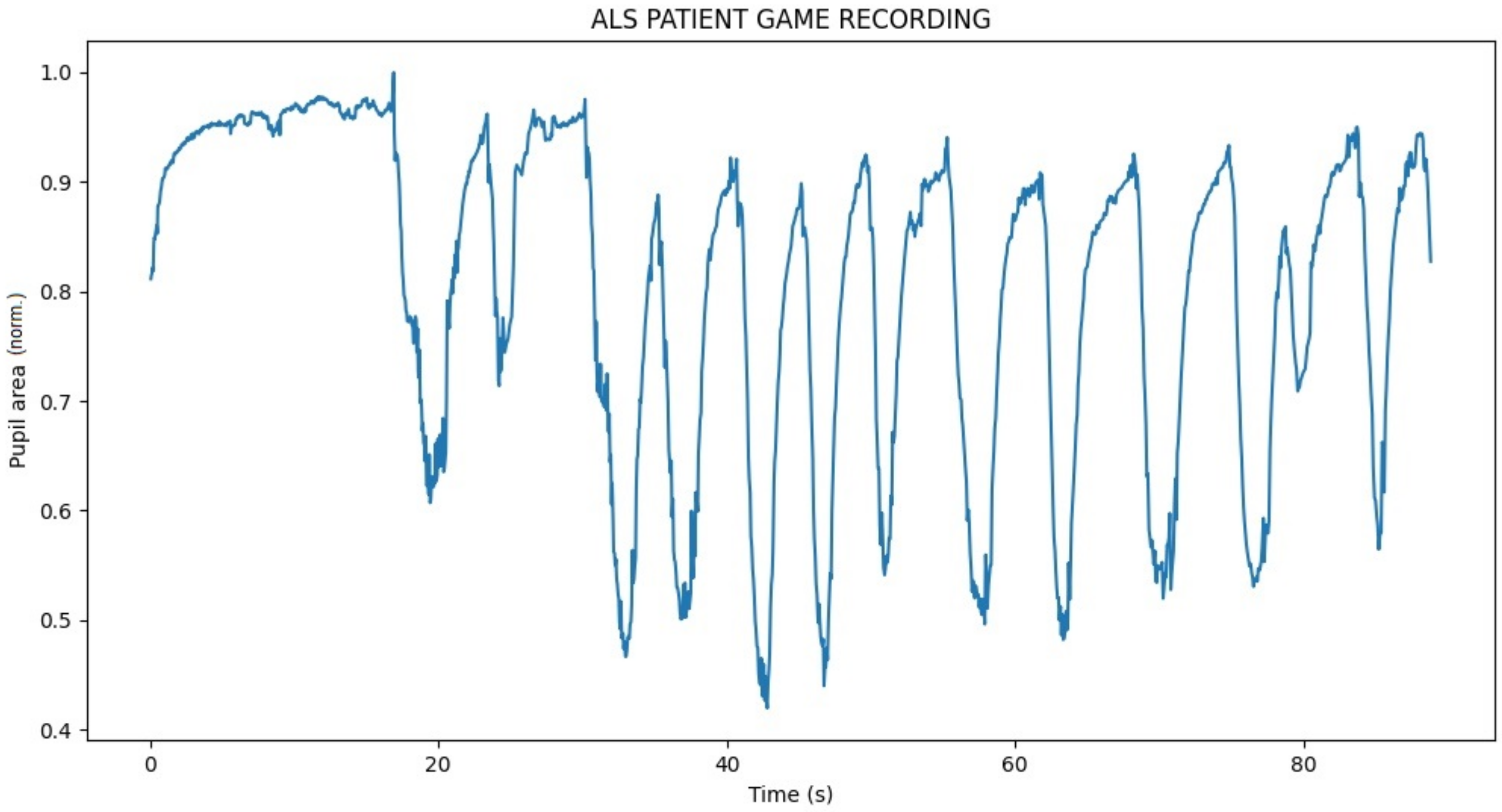
Publisher’s Note: MDPI stays neutral with regard to jurisdictional claims in published maps and institutional affiliations. |
© 2022 by the authors. Licensee MDPI, Basel, Switzerland. This article is an open access article distributed under the terms and conditions of the Creative Commons Attribution (CC BY) license (https://creativecommons.org/licenses/by/4.0/).
Share and Cite
Cardinali, L.; Roatta, S.; Pertusio, R.; Testa, M.; Moglia, C. Gaming for Training Voluntary Control of Pupil Size. Electronics 2022, 11, 3713. https://doi.org/10.3390/electronics11223713
Cardinali L, Roatta S, Pertusio R, Testa M, Moglia C. Gaming for Training Voluntary Control of Pupil Size. Electronics. 2022; 11(22):3713. https://doi.org/10.3390/electronics11223713
Chicago/Turabian StyleCardinali, Leonardo, Silvestro Roatta, Raffaele Pertusio, Marcella Testa, and Cristina Moglia. 2022. "Gaming for Training Voluntary Control of Pupil Size" Electronics 11, no. 22: 3713. https://doi.org/10.3390/electronics11223713
APA StyleCardinali, L., Roatta, S., Pertusio, R., Testa, M., & Moglia, C. (2022). Gaming for Training Voluntary Control of Pupil Size. Electronics, 11(22), 3713. https://doi.org/10.3390/electronics11223713






